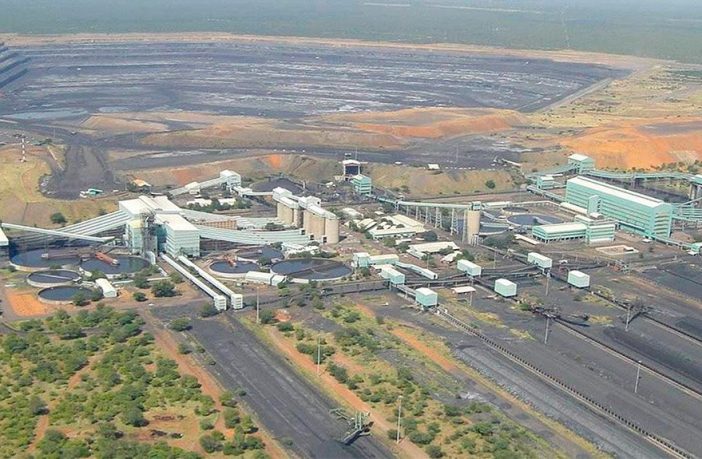- Exxaro Resources Limited’s (Exxaro’s) annual company reports emphasise its support for the goals of the Paris Agreement and acknowledge climate risk and coal’s contribution to global emissions.
- Exxaro recognises the need to transform its coal and heavy minerals mining business into one that supports the low-carbon transition.
- However, Exxaro has neither a Paris-aligned decarbonisation strategy nor science-based emission reduction targets.
Exxaro acknowledges that “the largest contributor to our emissions profile is from our scope 3 emissions” (i.e., the burning of the coal it sells), but it appears to have no plan at all to reduce these emissions.
In fact, although these emissions make up 98.6% of the company’s total emissions, they are completely excluded from Exxaro’s emission reduction targets. This exclusion renders meaningless the company’s claimed commitment to the goals of the Paris Agreement, and to climate science, because achievement of the Paris goals requires an urgent and rapid shift away from coal production. Even for developing nations, coal production must “begin an immediate decline, reducing by half within a decade with all extraction ceased by 2040”.
By 2050, Exxaro envisages that its coal will be mined efficiently, and that its coal mines will be powered by renewable energy, making the mining process “carbon neutral”. But Exxaro envisages that the fossil fuel itself will still be sold and burned by its customers, for which Exxaro takes no responsibility.
Key take-aways:
- Exxaro does not produce a standalone report in terms of the recommendations of the Task Force on Climate-Related Financial Disclosures (TCFD), but rather sets out the TCFD-recommended disclosures and indicators in a table, and then directs the reader to the various places in its 248-page ESG report and 158-page annual integrated report where these disclosures are made. While there is an argument to be made for incorporating TCFD disclosures into other reports in this way, it must be noted that the length of these reports, and the multitude of repetition they contain, renders them extremely user-unfriendly.
- Exxaro does not shy away from acknowledging climate change, and the precariousness of a coal business in the transition to a low-carbon world. However, it claims to have a “decarbonisation plan”, in circumstances where such strategy and targets as it does have, will not result in significant decarbonisation at all.
- Although Exxaro claims to be transforming into a “diversified company”, it seeks to maximise the value of its coal assets for as long as possible. Rather than planning to responsibly wind down these assets on a Paris-aligned timeframe, it will invest capital to maintain a “robust coal portfolio” and to ensure that its coal business “remains resilient”.
- In 2021, Exxaro committed to publishing “interim targets and plans to achieve net zero by 2050”. However, Exxaro does not have a Paris-aligned decarbonisation strategy or science-based emission reduction targets. Such targets as it has set, do not apply to its scope 3 emissions (the emissions from the use of its products), which make up approximately 98% of Exxaro’s emissions. It is also not made clear what baseline Exxaro uses for its emission reduction targets – which is clearly crucial for evaluating progress.
- In the medium-term, Exxaro has set a target to reduce its scope 1 and scope 2 emissions by “at least 40% by 2030” (presumably from a 2020 baseline).
- In the short-term, Exxaro refers to “[a]ctual for previous year less 5%” for its scope 1 and 2 emissions (presumably starting in 2022). This is not explicitly reported as a target, but is included in a table of the company’s emissions.
Exxaro appears to suggest that the only way it can reduce its scope 3 emissions is by “educating” its stakeholders: This is a bizarre abdication of responsibility, reminiscent of the widely criticised and ridiculed campaigns by big oil companies to “help” their customers reduce their personal carbon footprints, while allowing them to continue with a business-as-usual approach of maximising sales from fossil fuels.
Exxaro states that its decarbonisation plan requires it to address three main areas: operations optimisation; value chain partners; and stakeholder engagement, but it does not appear to have detailed plans to achieve its emission reduction targets. Beyond 2025, it simply refers to green hydrogen, methane capture and use, carbon capture use and storage and emissions offsetting as “opportunities” to reduce emissions that Exxaro is “evaluating and considering”.
Exxaro depicts the potential emission reductions that are being considered up to 2025 as estimated to bring its Scope 1 and 2 emissions down by 56% against its current (2021) Scope 1 and 2 emissions. If this is the case, it is unclear why:
- no target is set for 2025; and
- its target for 2030 is only a 40% reduction in Scope 1 and 2 emissions.
Author: Bryan Groenendaal
Source: JustShare











